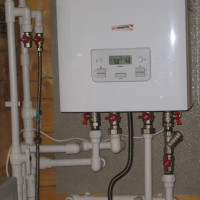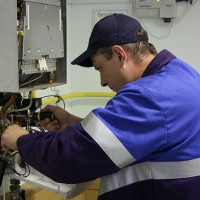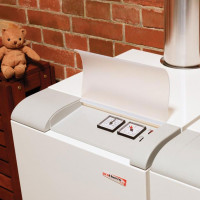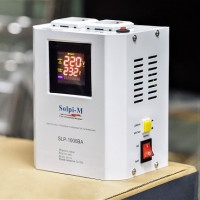Rules for connecting a dual-circuit gas boiler to gas
The main purpose of domestic gas boilers is to provide housing with heating and hot water. It is impossible to deal with the installation of such equipment on your own, since installation work and the operation of gas appliances involve certain risks.
However, the owner of the house is directly involved in the design of the boiler room, the layout of the heating circuit, etc. In order to be able to control the performers, you need to understand how the unit works, what is the scheme for connecting a dual-circuit gas boiler to the central gas pipeline and blue fuel cylinders.
The answers to these questions are detailed in the article. In addition, we have identified technical requirements that are important to observe during the design of the boiler piping, its installation and use of gas equipment.
The content of the article:
How do double-circuit gas boilers work?
As a rule, gas appliances are installed under the heating closed systemwhere the value of the water pressure is not higher than 0.3 MPa. If we talk about how to properly connect a home gas boiler, the answer is obvious.
The scheme of artificial circulation of a coolant with an expansion vessel is traditionally used. To prepare hot water with gas equipment, a centralized supply of cold water with a pressure of 0.02 - 1.0 MPa is used.

True, the exact values are determined by the specific brand of equipment and the manufacturer. Choosing a double-circuit boiler made according to specific installation conditions.
Boiler heating circuit diagram
The gas boiler heating circuit is by default designed to fill the cold water supply of the central water supply.It is also allowed to operate heating equipment when glycol-based water with antifreeze is used as a heat carrier (C2H4(OH)2) certified according to GOST.

The coolant coming from the return line of the heating circuit is sent through a filter to the heat exchanger, the design of which allows the initial filling and periodic replenishment of the heating circuit with water from a centralized water supply.
Further movement of the coolant activates the circulation pump, the design of which contains an automatic air vent. Then, the water flow passes the zone of the minimum flow rate sensor and is fed to the input of the first (external) coil of the coaxial type heat exchanger.
Moving along the heat exchanger, the water is heated due to the energy of combustion of the gas.

At the outlet of the heat exchanger, on the coolant supply pipe, there is an immersion temperature sensor. It is mounted here safety valve spring action equipped with a pressure relief mechanism.
The upper limit for opening the safety device is 0.3 MPa. A diaphragm expansion tank is also included in the supply line.
DHW circuit function
The DHW scheme works something like this: cold cold tap water under pressure from a centralized water supply is fed through a strainer to the water block. The block design made of brass provides the possibility of initial filling and periodic replenishment of the DHW system.

Further, through the installation area of the water flow sensor and through a magnetic anti-scale device, water enters the internal channel of a coaxial heat exchanger made of copper. Due to the selection of heat from the walls of the heat exchanger heated by the heat carrier passing inside the heating circuit, cold water is heated.
The hot water preparation mode provides for a temporary shutdown of the boiler circulation pump. An immersion temperature sensor is located at the outlet of the heat exchanger, which records the operating parameters of the supply line.
Here, on the boiler feed line, a second spring-loaded safety valve with a pressure relief mechanism is installed. The response limit is usually 1.0 - 1.1 MPa.
Natural Gas Connection
The gas boiler is designed to connect natural gas, the technical characteristics of which correspond to GOST 5542. Fuel, as a rule, is supplied from a low pressure gas pipeline of 0.0013 - 0.0020 MPa. A filter screen and a control valve of the flare ignition device are installed on the supply line.

The electromagnetic gas valve maintains gas pressure stability at the inlet to the boiler burner mechanism. Therefore, regardless of gas pressure fluctuations on the line, stable, safe functionality with high efficiency is ensured.
The electronically controlled gas burner power is regulated within 40-100% of the declared rated power.
The method of connection to the gas line
Before considering options for connecting natural gas to the boiler, you should recall the established rules for the operation of such equipment. Gas-fired boilers are hazardous technological facilities.
Installation, connection and operation of such systems requires compliance with established safety standards.

Gas boilers are mounted only inside suitable premises for installation (kitchens, corridors, utility rooms). This refers to the premises of public production buildings, private houses, cottages. All of these properties must comply with the requirements for the presence of effective ventilation.
As a rule, compliance is determined by SNiP 42-01-2002 and SNiP 2.04.08-87. When solving the problem of how to connect the boiler to the gas line, you need to remember that the operation of the equipment requires the construction of a mechanism smoke exhaust to the atmosphere. In addition, it is necessary to provide atmospheric air for an efficient combustion process.

Gas boilers supporting the function of the natural withdrawal of combustion products are to be installed in close proximity to chimneys with natural draft.
For equipment whose design provides for air intake directly at the installation site, a normal level of air discharge should be ensured. Inside such rooms, the air should be cleaned of dust and chemical impurities.
Technical nuances of connection
The process of connecting a gas boiler to a gas pipeline using a flexible hose is accompanied by its technological and technical features. So, laying the gas pipeline and subsequent connection to the boiler is permissible only for gas specialists.

Before connecting the gas boiler, it is necessary to clean the failed section of the gas pipeline from foreign substances, impurities, and contaminants. This requirement is especially relevant for mounting on used systems.
The gas inlet must be equipped with shut-off valves designed to work in a gas environment, supplemented by a thermal blocking device (TAE). Before connecting the gas pipeline to the boiler, it is required to check the tightness of all connections and gas pipeline connections with a test pressure of at least 0.15 ATI.
The cross-section of the exhaust gas pipeline must correspond to the diameter of the nozzle on the flow protection device. Narrowing the passage of the exhaust gas pipe is allowed, but only if the calculations justify (according to GOST standards) the correct functioning of the line.
The exhaust gas pipeline is shortened (if possible), with some bias in the ascent to the chimney.

The line supplying gas to the boiler is usually made on the basis of a metal pipe. It is allowed to construct supply lines on the basis of steel and copper pipes.
Meanwhile, permitted installation by polymer pipes (multilayer, with a metallized layer) is not excluded. True, polymers are allowed to be used only inside buildings with a height of no more than three floors.
Using a flexible hose
It is permissible to connect the gas source to the boiler using flexible hose.
The condition for the use of a flexible sleeve:
- resistance to the gas environment;
- conformity to working (test) pressure;
- compliance with the working (test) temperature.
The marked characteristics and parameters can be taken from the boiler data sheet. In this case, the flexible hose used must have a diameter of 20 mm or more, and the sleeve length can be no more than 1.5 m.

Connection with flexible hoses (sleeves) must be carried out in full accordance with the installation rules specified in the accompanying documentation of the product manufacturer.
Features of connection with cylinders
Flexible hoses (sleeves) often connect SG cylinders with a boiler installation. However, to turn the boiler on precisely in this mode of fuel replenishment, a number of settings are required to transfer the equipment to operation with bottled gas.
If the boiler design supports this type of supply, the instruction describes the sequence of operations.
Here, the technological requirements for sleeves of a flexible structure practically do not differ from the requirements for connecting to a centralized highway. Also, the sleeve diameter is not less than 20 mm with a length of not more than 1.5 m. However, the gas cylinder should be equipped gearboxset to a pressure of 2.9 kPa (vapor medium).

Separate standards have been approved for cases of boilers supplying liquefied gas with liquefied gas, in particular those related to the storage and operation of cylinders. For example, it is forbidden by these standards to place vessels in areas exposed to sunlight, near heat sources and open flames.
One of the main prohibitions is the taboo on installing gas equipment directly inside buildings.
An overview of LPG gas boilers is given in this article.
Thus, the use of gas boilers in practice, including the domestic sphere, must be considered a responsible action, the accuracy of which determines the degree of safety.
Conclusions and useful video on the topic
A few useful tips for installing a gas boiler will help you verify the correct installation of the equipment.
With all the perfection of gas equipment, in the presence of automation and serious technological protection, connecting the system requires compliance with established rules and norms. Without this, it is impossible to guarantee the reliability of gas boilers.
Have something to supplement, or have questions about connecting a dual-circuit gas boiler? You can leave comments on the publication and participate in discussions of the material presented. The feedback box is below.

 The principle of operation of a dual-circuit gas heating boiler and features of its connection
The principle of operation of a dual-circuit gas heating boiler and features of its connection  Connecting a double-circuit gas boiler to the heating system: requirements and norms + installation steps
Connecting a double-circuit gas boiler to the heating system: requirements and norms + installation steps  Replacing a gas boiler in a private house: norms and rules for completing the procedure for replacing gas equipment
Replacing a gas boiler in a private house: norms and rules for completing the procedure for replacing gas equipment  Installation of a gas boiler Protherm: features and main stages of installation + wiring diagrams
Installation of a gas boiler Protherm: features and main stages of installation + wiring diagrams  Gas generator for a gas boiler: specifics of choice and features of connection
Gas generator for a gas boiler: specifics of choice and features of connection  Voltage stabilizers for a gas boiler Baxi: TOP-12 of the best models according to consumers
Voltage stabilizers for a gas boiler Baxi: TOP-12 of the best models according to consumers  How much does it cost to connect gas to a private house: the price of organizing gas supply
How much does it cost to connect gas to a private house: the price of organizing gas supply  The best washing machines with dryer: model rating and customer tips
The best washing machines with dryer: model rating and customer tips  What is the color temperature of light and the nuances of choosing the temperature of the lamps to suit your needs
What is the color temperature of light and the nuances of choosing the temperature of the lamps to suit your needs  Replacement of a geyser in an apartment: replacement paperwork + basic norms and requirements
Replacement of a geyser in an apartment: replacement paperwork + basic norms and requirements
It is written expanded and accessible, the text is supplemented with practical tips and nuances. From my personal experience, I can add the following regarding the connection of a gas double-circuit boiler: you need to hang (fasten) it at the correct height. Since the master hung it too high for us, almost to the ceiling itself, which led to the accumulation of gases. The ventilation ducts could not cope. There was a smell of gas in the house, and the boiler flashed constantly when turned on. This led to the breakdown of our equipment.
Although there is a boiler at home for heating water, when designing a gas supply and installing a boiler, the double-circuit type was indicated in the contract. I got acquainted with your information, and realized that I had not lost. Although many "experts" advised single-circuit. I still have to buy it, find a suitable option for my limited budget. And there will be me and my family happiness in the winter, otherwise the firewood will end :)